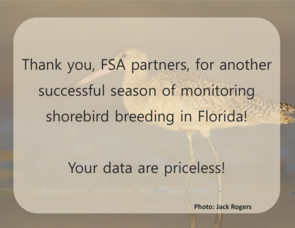Events:
December 14: Birds of the Beach at Rookery Bay
December 15 - January 5: Audubon's 120th Christmas Bird Count
Atlantic Flyway Disturbance Project
A significant threat shorebirds and seabirds face is disturbance from human activity. To better understand the effects, in 2017-2018, the National Fish and Wildlife Foundation funded Phase I research by National Audubon Society, Virginia Tech, and Birds Canada on human disturbance of five focal shorebird species (American oystercatchers, piping plovers, red knots, semipalmated sandpipers, and Wilson's plovers). Biological data was combined with human dimensions research on beach recreationists and a survey with land managers at Important Bird Areas across the Atlantic Flyway. Study sites were distributed across Florida, South Carolina, North Carolina, Connecticut, New York, Main and Nova Scotia. Point count transects were established to systematically survey both shorebirds and disturbance. In Florida, surveys were conducted in various seasons at Anastasia State Park, islands near Cedar Key, Three Rooker Island, Outback Key and Fort Desoto County Park, Marco Island, and Crandon Beach Park in Miami.
In addition to better understanding the impacts from the types of disturbance, the research also explored how to effectively work with beach recreationists to reduce the threat of human disturbance. Human dimensions researchers conducted interviews with beach visitors in northeastern U.S. states. Additionally, land managers were surveyed for their views on the most significant sources of disturbance to shorebirds and what resources are most needed to effectively manage disturbance. Continuing the initial research, Phase II work began in late summer 2019 and will continue disturbance sampling at sites where those data were collected in Phase I. Phase II also includes an on-beach pilot project on the coast of Georgia to evaluate the effectiveness of changing the behavior of off-leash dog walkers. To learn more about Florida's participation in the project, email Marianne Korosy of Audubon Florida.
Read the full reports - Atlantic Flyway Disturbance Project:
Final Report
Land manager Survey
Understanding Beach Recreationists
Photo: Pat Leary


FSA Partners Complete Another Season of Successful Breeding Monitoring
A HUGE thank you to everyone who monitored this year! Monitoring shorebird and seabird populations is a fundamental strategy for conservation success across the state. Your efforts directly impact the viability of shorebirds and seabirds. Here is a snapshot of the 2019 effort:
In 2019, 246 partners entered data and visited 322 rooftops a total of 2,530 times. You also surveyed 343 routes, covering 892 miles of Florida coastline.
Did you know that every monitoring survey you record is reviewed by a member of our Data Team? We review the information piece by piece to better understand what’s happening with shorebirds statewide. When we want to know more, we check the comments you entered. And if we have questions, we ask the experts – you
By reviewing every piece of information you submit to the Florida Shorebird Database, we ensure the data set is consistent and reliable. This helps us inform adaptive management strategies and identify information gaps. Thank you for each and every monitoring record you submitted in the 2019 breeding season. Your data are essential for advancing shorebird and seabird conservation in Florida!
|

|